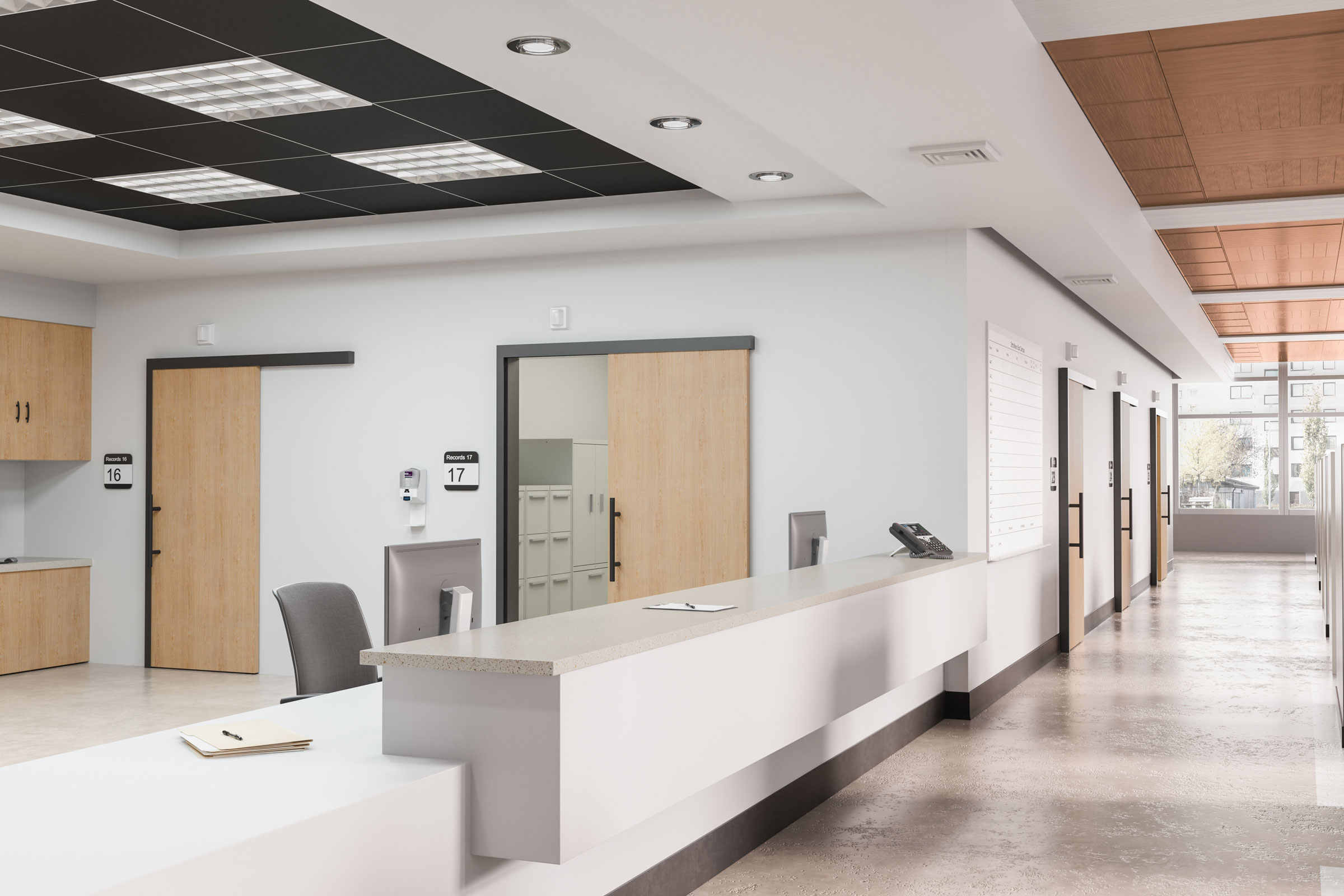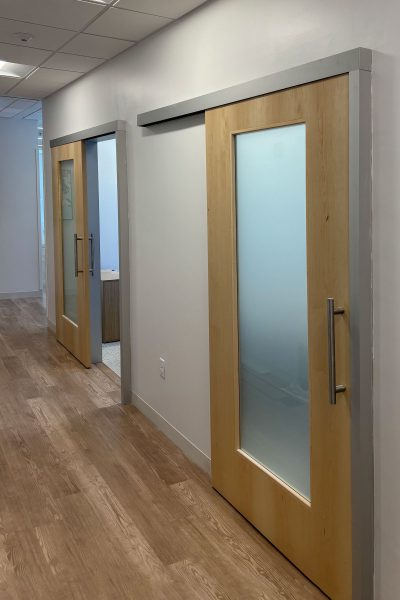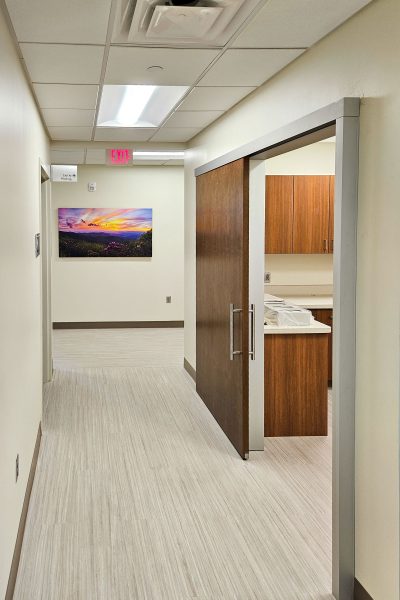Story at a glance:
- Innovative technologies are improving privacy, acoustics, flexibility, and sustainability in health care.
- While SpecSlide launched in 2024, new configurations are in-process for many applications—from the single-slide and bi-parting available now to self-closing and telescoping.
- SpecSlide has been a popular option for design teams in health care to gain more square footage in exam rooms and offices.
Privacy, durability, cleanability, even the look and feel of nature—this is just some of what’s required across health care projects today. Doors are no exception.
The team at Special-Lite—an industry leader in high-performance door systems for more than 50 years—is seeing more demand for easy to clean and touchless access to reduce infection risks in the health care space. Quiet, private environments that support healing and reduce stress are also a must, according to Kaden Stinger, architect engagement specialist at Special-Lite, while ADA-compliant doors help ensure accessibility.
Stinger spends a lot of time in the field hearing from architects and facility managers about what they need. “When you think about those who may be specifying or designing with these products, they’re always looking at sustainable materials, long life products, always attempting to reduce maintenance or overall life cycle costs, and then they have to have compliance. At the end of the day facilities managers and designers want that compliance built in,” he says.
Architects at CannonDesign consider the makeup of every material that goes into a project from the very beginning—including how to clean the materials and how each will stand up to a busy environment like health care. “We’re always cognizant of how people clean the materials we’re choosing,” says Dale Greenwald, CannonDesign’s Interior Design Leader. “The material has to be durable, it has to be long-lasting, and it has to stand up to the cleaning regimens that are in place.”
The Latest in Sliding Doors
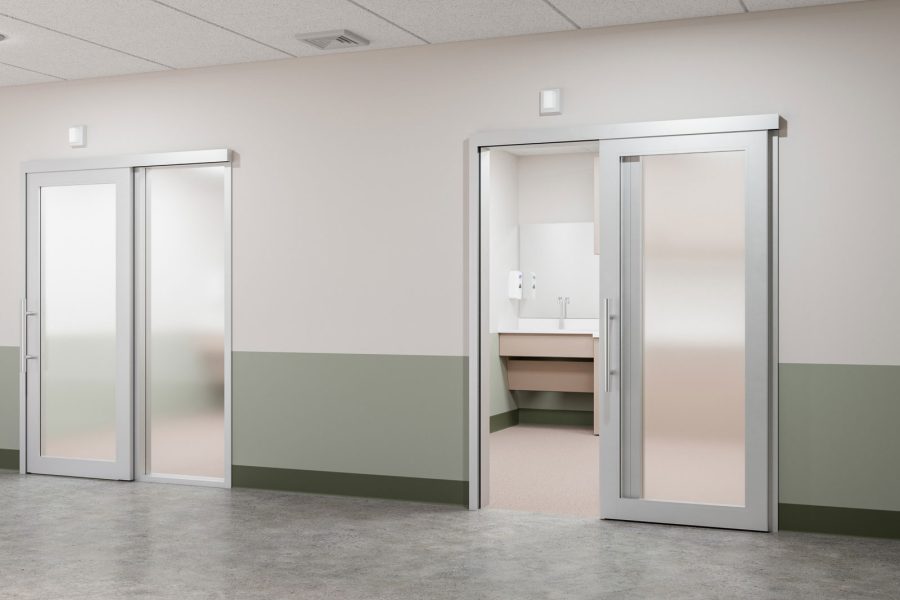
Flush Vision Panels with privacy glass provide adaptable, high-performance solutions that meet evolving facility needs. Privacy glass or applied films let in natural light while protecting privacy. Photo courtesy of Special-Lite
Stinger has been heavily involved with sliding door systems for nearly a decade and has seen demand grow as Special-Lite innovates to provide the custom solutions needed in the industry. “These are innovations that come from us listening to users and health care professionals and architects telling us what they are frustrated with, what impacts their everyday work life, and asking, ‘How can we provide something better?’”
The new SpecSlide Surface-Mounted Sliding Door System is a result of innovating to meet demand, Stinger says.
For new construction it allows more rooms to be built per floor.
The SpecSlide sliding door system is space-saving and versatile in terms of design and customization, and it’s also easy to install, easy to clean, and durable. SpecSlide can add up to 25 square feet of usable space to rooms. “This has been an increasingly popular option to gain more square footage in exam rooms and offices for retrofit applications, and for new construction it allows more rooms to be built per floor,” Stinger says.
Sliding doors seemed to be considered more widely in health care for the first time six years ago, Stinger says, but it’s a trend he says is here to stay, as that’s extra square footage that would be taken up by a swing door. “It seems like it increases every year because there are so many advantages—especially for architects or facility owners who are trying to fit more rooms per floor.” The systems work in new builds or retrofits and are ideal for high-traffic areas like patient rooms and consultation spaces, Stinger says.
Innovation
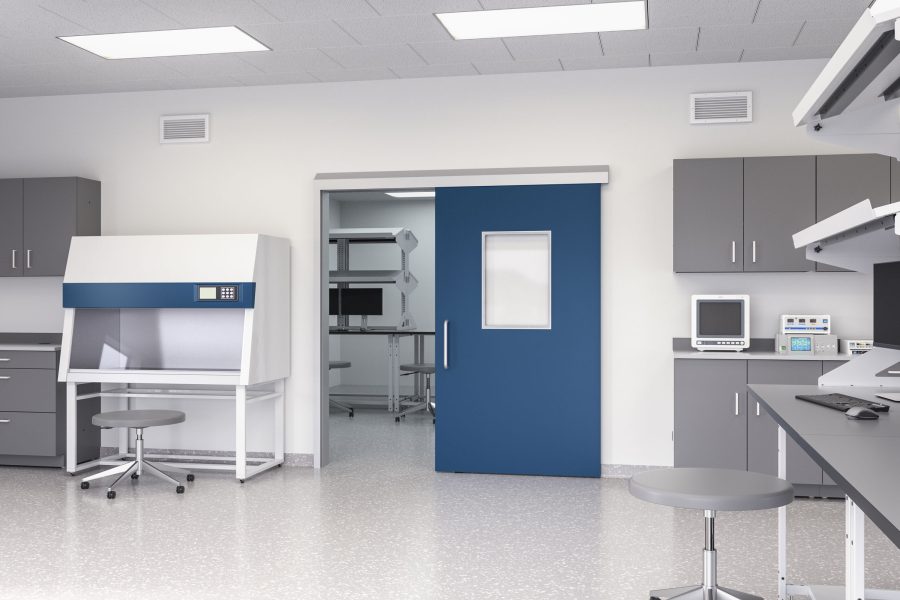
While SpecSlide launched in 2024, new configurations are in-process for many applications—from the single-slide and bi-parting available now to self-closing and telescoping. Photo courtesy of Special-Lite
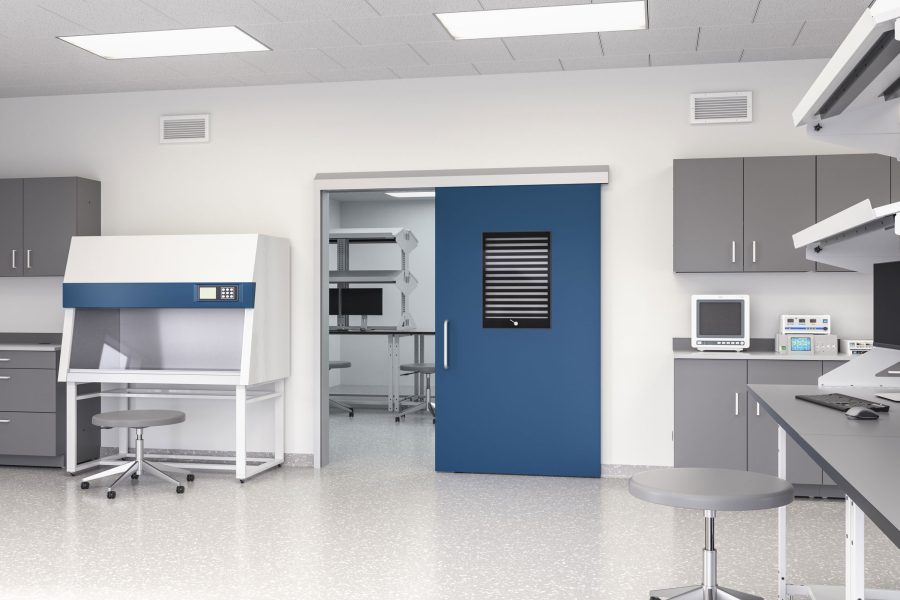
SpecSlide with clean room lab privacy window. Photo courtesy of Special-Lite
While many sliding door systems have limited hardware options or even no locking hardware available, SpecSlide offers locking hardware options with all common lock functions and electronic access control compatibility, Stinger says. For health care staff, efficient access control enhances security and workflow. “Special-Lite worked to develop this solution based on need; we heard from large health care systems,” he says. “We’re able to provide durability that goes much farther than the standard mechanism of competitors.”
Special-Lite also improved the receiving channel with SpecSlide, having a two-piece receiving channel that allows the cover piece to be removed and replaced if it were damaged. The extra-sturdy door receiver channel stands up to beds and carts and provides easy access to electrical hardware components. The cover piece acts as a raceway, so if a team wants to add electrified locks or access control later they can.
Special-Lite partnered with Hawa for the sliding hardware the door hangs on to add to the ease of installation. Hawa’s SoftMove also provides a soft open and close. Its magnetic operation overcomes the key failure point of sliding door systems—broken soft close triggers—and does not allow the door to be slammed, Stinger says, eliminating the chance for smashed fingers, for example.
The Special-Lite team tested SpecSlide over 500,000 use cycles, compared to the industry standard of 150,000, to ensure reliability. “We feel very comfortable with that trigger-less solution that is magnetically driven,” Stinger says. “It’s very unique overall and can be mounted in very versatile ways. We’re trying to innovate both on the functionality side as well as the aesthetic side. We can pair this system with any one of the aluminum systems we also produce.”
SpecSlide pairs easily with Special-Lite’s Dual-Glazed LiteSpace Framing, for example. The demountable system improves acoustics and space adaptability. “We can now pair these types of systems with those aluminum systems and give a very clean aesthetic as well as a very durable product,” Stinger says. And in health care, acoustics are critical in sometimes sensitive settings.
STC-rated door systems minimize noise disruptions and further ensure patient privacy and confidentiality. Special-Lite also offers Flush Vision Panels with Privacy Glass; operable blinds provide flexibility while allowing vision and light transmission when needed. Switchable privacy gives patients peace of mind, and the doors are still easy to sanitize.
That flexibility is a key consideration of architects. “There’s this idea that you’re being cared for and watched, but you still have the ability to have some privacy,” says John Reed, principal and senior design leader at CannonDesign, regarding design for patients.
Accessibility
In a hospital setting everything must be designed for accessibility, Reed says. At the Petrocelli Surgical Pavilion project that CannonDesign recently worked on (page 136), you can see accessibility at every turn.
“Doors are oversized, and the spaces you move through are designed for the scale of the bed that moves through them,” Reed says. “There’s a lot of work going into designing individual patient rooms and how they can accommodate family members also in the room to spend the night.”
But it’s not just the room and door sizes that show compliance; it’s also the material selection. “The materials that are selected have to be selected understanding that our clients can have impairments,” Greenwald says. “They could be visual impairments, they could be mobility impairments, and the smoothness of surfaces, the transitions of surfaces from one material to the next are always considered in what we are doing.”
The Special-Lite portfolio emphasizes smooth, low-maintenance surfaces that reduce cleaning time, with easy-to-clean materials like FRP, aluminum, and stainless steel. The Flush Vision Panels (with and without internal blinds) for doors are designed to be especially hygienic, while sloped fascia on sliding door tracks make it easy to see and clean the surface, and there is no “shelf” for dust to collect.
Special-Lite says its compliance with ADA and health care safety standards also ensures regulatory adherence. Wide, low-force sliding door options accommodate clear opening space and opening force requirements.
The Natural Look
- SpecSlide finishes include anodized, painted, and wood grain (seen here), with clear and black anodized in stock. Special-Lite offers standard wood doors or durable aluminum, hybrid FRP, or fiberglass doors. Photo courtesy of Special-Lite
- SpecSlide. Photo courtesy of Special-Lite
Special-Lite can powdercoat its aluminum or fiberglass doors to have a wood look to add a subtle, soft feel that opens up design possibilities for architects, Stinger says. In general, design teams can mix and match with wood doors or durable aluminum, Hybrid FRP, or fiberglass doors.
“We’re able to provide the desired look with a wood door or a wood grain FRP door as well as provide a hermetically sealed door in a fiberglass option that provides that very clean and durable surface they are looking for especially in a health care environment,” Stinger says.
Customization is seemingly endless, says Shelby Brooks, product and brand manager at Special-Lite. “We can really do whatever an architect wants. A lot of architects are used to FRP doors maybe having a bumpy, textured look, but we’re able to provide a ultra realistic wood grain that’s based off of real cherry and real oak wood. It’s cast from those materials.”
The wood look continues to be a topic of conversation among architects. “We’re looking for ways to emulate natural materials as much as possible because not all natural materials can be used in a health environment,” Reed says. “There are limited studies on how people respond to different kinds of materials. We’re always studying how the impact of materiality and color can affect the patient in terms of their feelings within the space and also the staff, how they perceive space.”
Real wood is a very difficult thing to bring into health care, Greenwald says, adding that 3D laminates can be problematic if they contain PVC. “There are a lot more choices now in terms of durable materials that can simulate natural materials, so that’s a great thing,” he says. “Our challenges are with finding materials that are PVC-free, that are sustainable materials that can still fall into the categories of durability and infection control. We’re always looking for new things, but at the same time we’re challenged with limitations in the marketplace.”
Special-Lite’s doors are PVC-free and give design control back to the architect, Stinger says. “With the wood doors that can be very limiting, especially when manufacturers tie you to a certain package that offers you three or four doors and three or four hardware sets. We’re really able to open up the options with customization.”
Greenwald says that while some newer materials on the market mimic natural materials, architects must still exercise caution and ensure what they choose is sustainable, easy to clean, and aesthetically pleasing. “Bringing textures in is important,” he says. “Everything can become very flat very quickly.” It’s all about balance, he says, trying to find things that look textural and may not actually be textural, because cleaning can be a problem if there are cracks and crevices in a product.
Brooks says Special-Lite will continue to innovate to meet industry needs. She says they continue to see demand for warm, inviting colors and styles reminiscent of home, for example. “Bringing in those wood finishes, whether it’s the door or an interior framing system or glass wall type application, you don’t have to use real wood. You could have something that’s easy to clean, super durable, and still has that warm look.”
Antimicrobial hardware, touchless, semi-touchless, glass, and even full-glass slide doors that are electrified or have access control built in are also growing in popularity, Stinger says. Former retail pharmacies have shown a need to convert former Covid vaccination spaces into infusion care centers and add doors, while saunas and spas are another example of innovative doors with unique needs around humidity. “Our versatility and the developments we add to these systems becomes broader as we listen more.”
Beyond being durable and easy to clean, Special-Lite doors are also GREENGUARD Gold–certified with low-VOC finishes to ensure indoor air quality. Special-Lite Interior Aluminum Framing and Doors also contribute to LEED points. Minimal maintenance needs reduce long-term operational costs, whereas many of the doors themselves are made using recycled aluminum content.
“Sustainability is a continuous journey for any manufacturer to keep improving, and it’s the same for Special-Lite, but our brand and focus starts with that longevity. These are durable products that don’t have to be thrown out or replaced,” Brooks says.

